

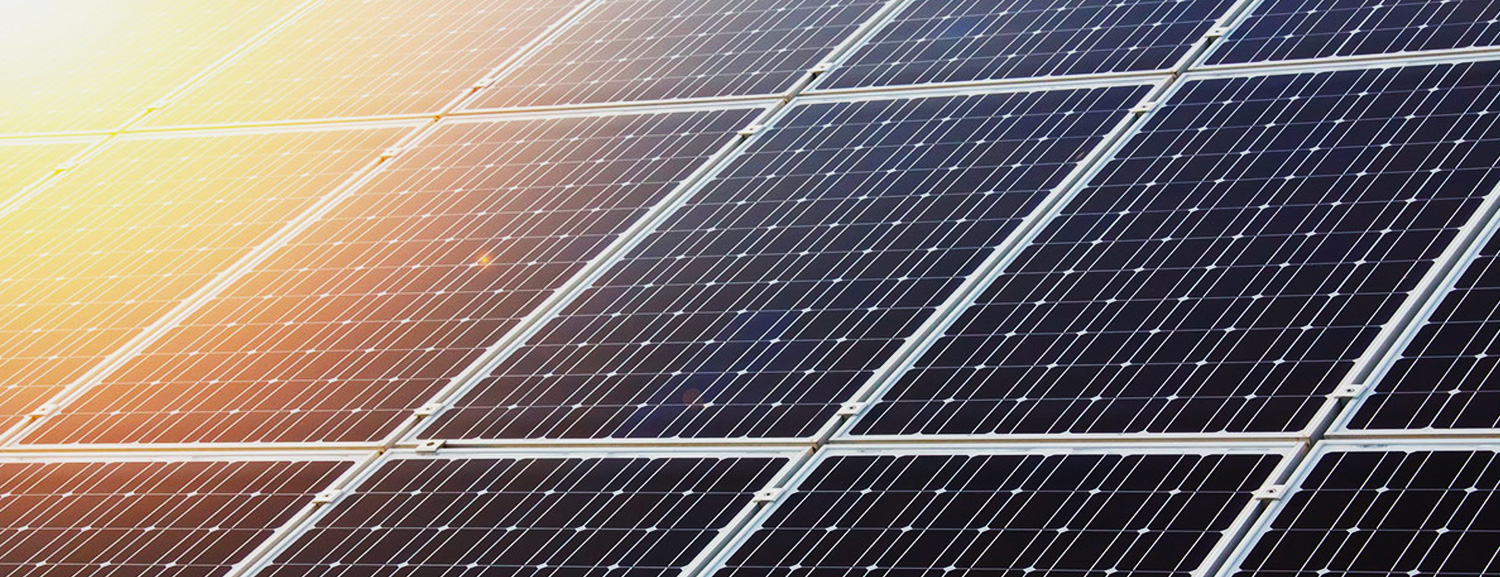
On their own, solar PV cells produce a limited amount of energy, but when arranged and electrically connected and mounted on a supporting structure, the result is a solar PV panel that combines the electrical output of each solar PV cell, yielding a greater amount of energy production. The power, or wattage, that a solar cell or a panel of cells can produce is determined by measuring its current and voltage.
Sometimes terms like “solar panel”, “photovoltaic cell”, or “PV panel” are used interchangeably when solar power is being discussed or described. They shouldn’t be.
When talking about solar power generation, there are two mainstream technologies:
Typically when people talk about solar cells, panels, or arrays they’re visualizing the panels they’ve seen on rooftops or out in fields. This is photovoltaic solar power generation, which is the solar technology that’s explained in STIKopedia and used in all Solar Stik Systems.
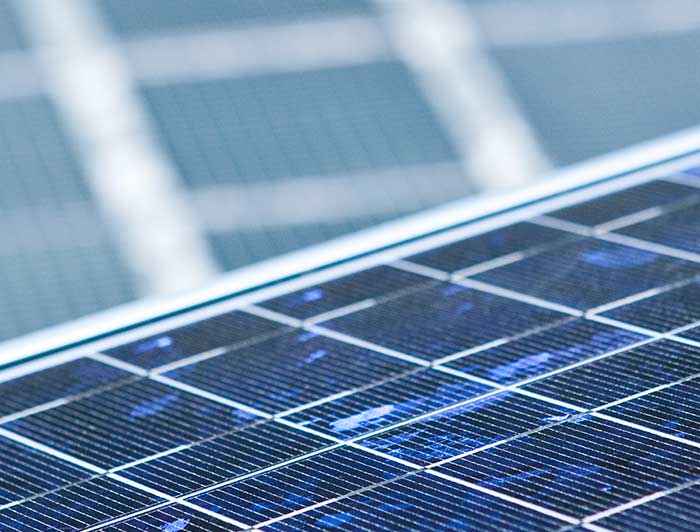
There are many different types of solar PV panels on the market, and for every panel type there are even more manufacturers. The chemistry, construction, and performance vary greatly between panels.
For years, companies have sought ways to reduce manufacturing costs associated with traditional PV technologies. This search has resulted in several types of technologies over the course of the industry’s evolution.
The two most common types of solar panel technologies are rigid (mono- or polycrystalline) ![]() and flexible (thin film)
and flexible (thin film) ![]() .
.
To make an apples-to-apples comparison between the types of panels, standard test conditions (STC) have been defined. STC uses the same conditions for all panels: direct, incident sunlight at an intensity of 1000 watts per square meter (W/m²); a cell temperature of 25 °C (77 °F); and an air mass of 1.5 (air mass, or density, affects the amount of sunlight that reaches the Earth’s surface).
The operating temperature of a module is determined by the equilibrium between the heat produced in the PV module, the ambient operating temperature, and the ability of the panel to dissipate heat through its encapsulant materials.
As temperatures increase, stresses associated with thermal expansion also increase, thereby increasing the degradation rates of the PV module by a factor of about two for each 10 °C increase in temperature over its STC ratings. Why does this matter? Proper panel mounting is very important! The hotter a solar PV panel gets, the more negatively its output power is affected.
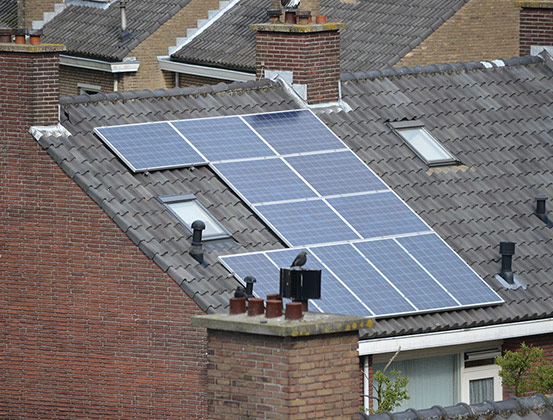
How to Read the Electrical Ratings Tag on a Solar PV Panel
Each module is rated by its DC output power under standard test conditions (STC) by the manufacturer.

Peak Power (Pmax) – the sweet spot of the solar panel power output, where the combination of the volts and amps results in the highest wattage; it is the point at which the MPPT electronics try to keep the volts and amps to maximize the power output
Voltage (Vmpp) – the voltage when the power output is the greatest; it is the actual voltage you want to see when it is connected to the MPPT solar equipment under STC
Current (Impp) – the current (amps) when the power output is the greatest; it is the actual amperage you want to see when it is connected to the MPPT solar equipment under STC
Open Circuit Voltage (Voc) – the volts the solar panel outputs with no load on it; it is the maximum voltage that the solar panel can produce under STC
Short Circuit Current (Isc) – the amps (current) the solar panels are producing when not connected to a load but when the plus and minus of the panel’s wires are directly connected to each other; it is the highest current the solar panels will produce under STC
Using solar PV power reduces dependence on traditional means of generating power (grid power or fuel-driven generator). Other benefits of using solar power generation include:
Applications needing more power generation should consider using a high-efficiency, hybrid system.
Solar panels generate power anytime there is daylight, even on a cloudy day, making them a guaranteed power source. This makes them 100% effective, but not 100% efficient. The efficiency of solar panels is measured by how much solar irradiance a panel is able to convert to electricity. Single-junction solar cells are the most common solar cells. They typically convert anywhere from 10 to 20% of the sunlight received into electricity. By comparison, a record for solar cell efficiency of ~46%—using a four-junction concentrator-type cell—has been established by the National Renewable Energy Laboratory (NREL). It will be some time before this type of multi-junction solar cell technology is readily available.

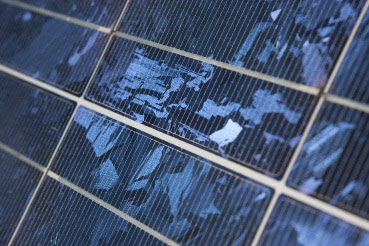
Rigid monocrystalline is the first generation of solar PV panel technologies and is still the most efficient, setting the standard for other PV technologies; however, advancements in manufacturing technology have increased the efficiency of the multi- or polycrystalline panels to almost that of monocrystalline panels. While they are similar with efficiencies of 15 to 20%, monocrystalline panels are slightly more efficient in full sun, while multi- or polycrystalline panels deliver slightly higher output during periods of partial shade.
Flexible solar panels are less efficient than their rigid cousins. Amorphous silicon cells can achieve an initial efficiency of 10%. Copper, indium, gallium, selenide (CIGS) cells with steel backing offer efficiency of up to 15%. CIGS panels are more efficient than amorphous silicon, but fare worse in low-light situations.
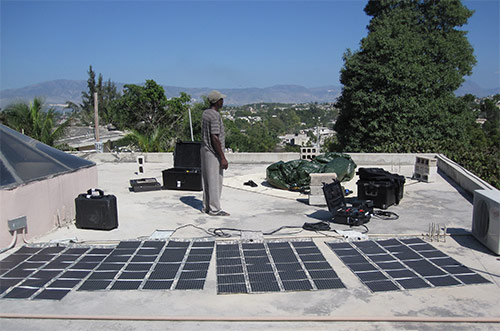
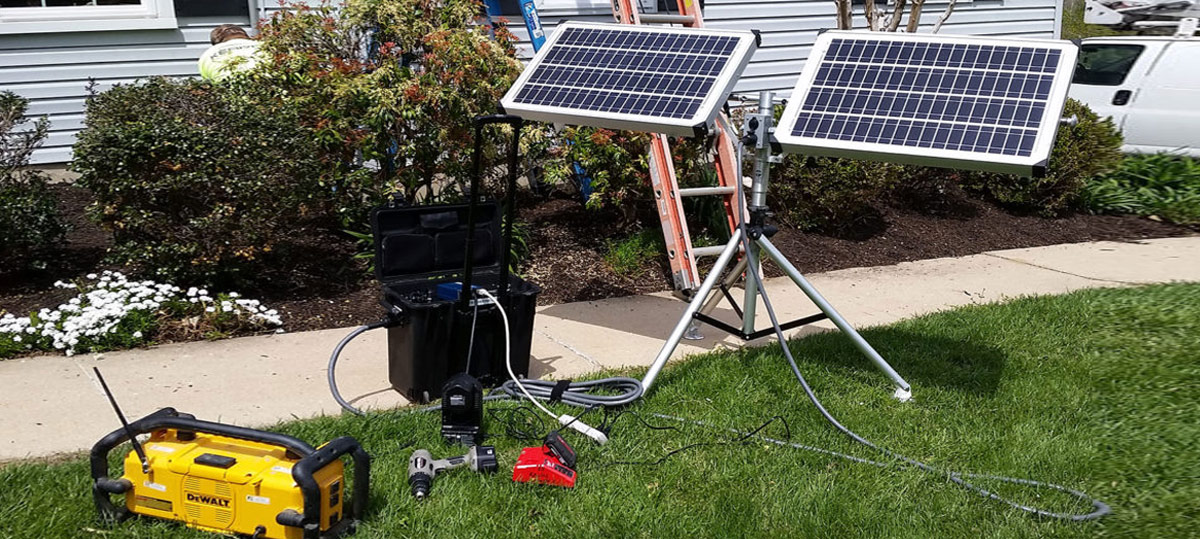
Purchasing solar PV panels is the only direct cost associated with using them. Once you own them, the panels produce power for their rated life expectancy for free as long as there is sunlight. Invest in a panel that suits the intended application to withstand operating environmental challenges such as heat, inclement weather, and rough physical treatment.
When choosing or replacing a solar PV panel or array, the cost varies according to the type of panel. Rigid, silicon-based crystalline solar PV panels are widely considered to be the best technology available. However, this high quality corresponds with a higher price, making these panels the most expensive on the market.

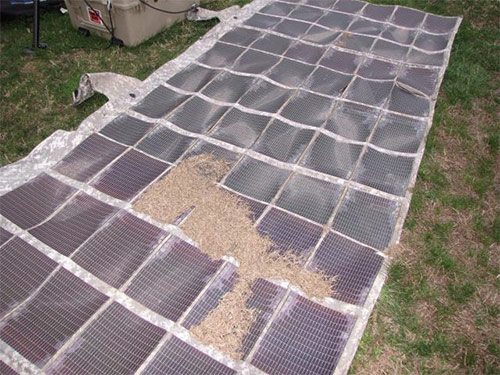
Thin-film solar PV cells are less expensive to produce than silicon cells because they require fewer materials for construction. Because it takes very little material to make thin-film cells, this technology generates a lot of interest within the solar power industry.
Much like their rigid-panel cousins, thin-film PV technologies can produce power for many years. The lifespan of thin-film solar PV panels is limited by their physical construction. Many materials used in these panels, such as plastics and fabric, degrade with use and exposure to the elements.
In severe environments, a CIGS panel with a heavy-duty plastic or stainless-steel substrate usually lasts longer than an amorphous silicon panel of lighter-duty construction with the same power rating. Examine the physical construction of any flexible solar PV panel to ensure it suits the intended application.
Thin-film panels require more care and maintenance than rigid panel technologies. When buying, beware of cheaply produced thin-film panels. The PV technology may be well-crafted, but if the construction is poor, the panel may become unusable quickly.

We consider ourselves authorities in portable power and students of its application. STIKopedia reflects that and is updated continuously as the industry grows and evolves.
Questions? Comments? Click the compass at the upper left to contact us.
Solar PV panels generate power anytime there is daylight—even on cloudy days—but to operate at rated capacity, they must be placed in direct sunlight, allowing photons to pass directly into the cells. Sunlight is “direct” when it is within a 15-degree angle (in any direction) of being perpendicular to the solar panel. This translates to about a 30-degree angle “window” where the panel will operate at maximum output.
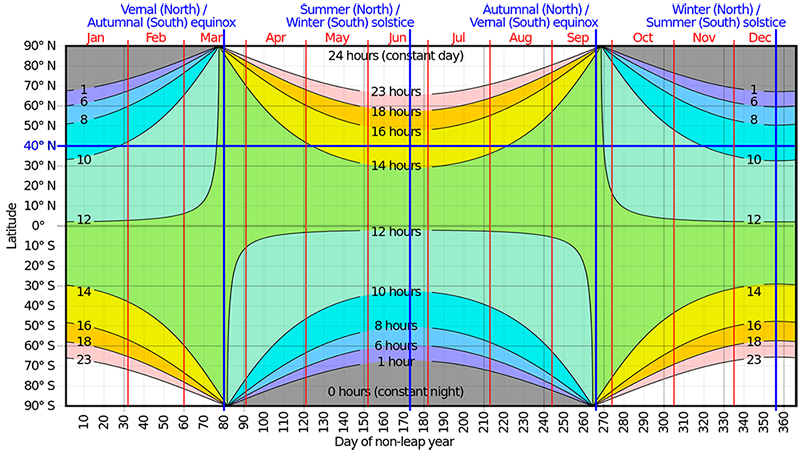
This chart illustrates the sunlight one can expect during any time of the year at any latitude and in either hemisphere. The horizontal blue line highlights the seasonal variation of the hours of sunlight at 40º N latitude. This parallel crosses through or near to Chicago, Istanbul, Beijing, and Madrid.
Sunlight hitting a solar PV panel directly is absorbed most efficiently. If sunlight hits panel at an angle, the photons will be reflected more and absorbed less. Only absorbed photons can be converted into electricity. The amount of photons passing through a solar panel corresponds directly to its output current, and how this happens is explained by the elemental substances contained in a solar PV cell.
Solar cells consist of four main substances: silicon, phosphorus, boron, and copper. Each substance serves a purpose in the operation of converting sunlight to electrical energy. Silicon is essential to the function of solar cells because it is a semiconductor. The octet rule states that for an atom to become stable it must react or combine with other atoms to achieve a stable outer shell configuration of eight electrons. Because silicon has four valence electrons, it can share its electrons with other silicon atoms to form a solid crystalline structure. However, this characteristic of silicon means that no electrons are free to move, rendering silicon a poor conductor. This is why phosphorus is added to a piece of the silicon in a solar cell in a process known as doping. Because phosphorus has five valence electrons, four of those electrons are shared with four silicon electrons, but there is still one phosphorus electron free to move around so electrons can flow and electricity conducts better. The resulting silicon from this addition of phosphorus is known as N-type (negative type) silicon due to the prevalence of free electrons.
The other piece of the silicon is doped with boron because it has only three valence electrons (one less than silicon). This means that when a silicon atom and a boron atom share electrons, they will each have seven valence electrons, creating a gap for an electron to fill. The resulting silicon from this addition of boron is known as P-type (positive type) silicon due to the space available for electrons to fill.
However, if a solar cell is to produce electricity, there has to be an electric field to move the electrons; this is achieved by placing the P-type and N-type silicon pieces in contact with each other. When this is done, some of the loose electrons on the side of the N-type silicon in contact with the P-type silicon flow and fill some of the gaps available at the edge of the P-type silicon. This forms a barrier that makes it harder and harder for the electrons to flow from the N-type to the P-type silicon, and eventually equilibrium is reached between free electrons and electron gaps, resulting in what is known as the PN-junction. Because the barrier offers too much resistance for all the electrons to cross, an electric field between the two silicon types is created.
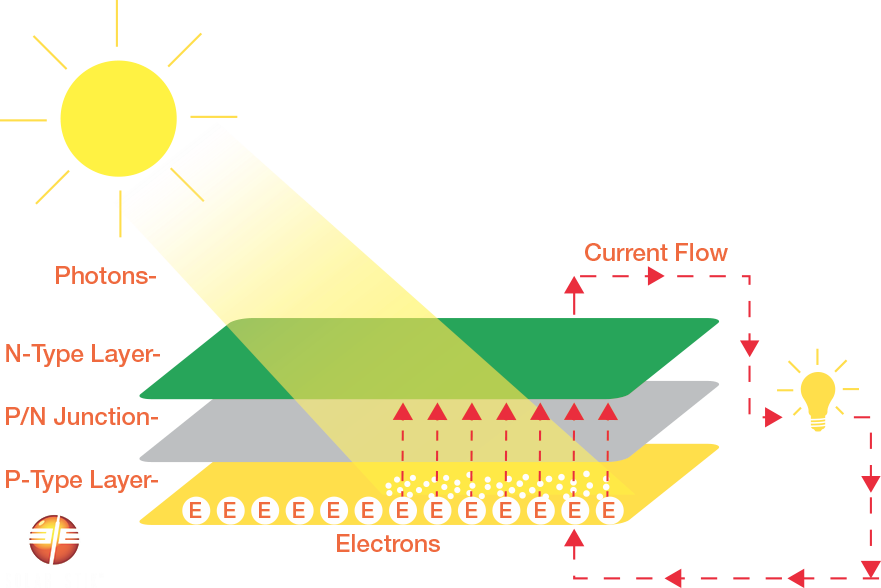
When the N-type silicon exposed to a source of light absorbs light in the form of photons, the silicon atom absorbs the quantum of energy and releases an electron. Because the electric field causing the electrons to want to travel from the N-type silicon to the P-type silicon is blocked by the electron barrier, copper wires are run through the solar cell so the electric field is channeled throughout them, causing loose electrons to be drawn through the wire. The flow of electrons produces electricity, and the copper wires become the negative and positive terminals of the solar cell.
When the electrons are released by light energy, they flow through the wire and to the P-type silicon, doing work on the way. Eventually enough electrons accumulate in the P-type silicon to disrupt the equilibrium. This causes some of the electrons at the PN-junction to flow through to the N-type silicon and some of the free electrons in the P-type silicon to re-form the barrier, so the equilibrium at the barrier is constantly maintained as the electrons flow. The current output of the solar cell depends on the flow of electrons, and the voltage is determined by the intensity of the electric field.

Sunlight hitting a solar PV panel directly is absorbed most efficiently. If sunlight hits panel at an angle, the photons will be reflected more and absorbed less. Only absorbed photons can be converted into electricity. The amount of photons passing through a solar panel corresponds directly to its output current, and how this happens is explained by the elemental substances contained in a solar PV cell.
Solar cells consist of four main substances: silicon, phosphorus, boron, and copper. Each substance serves a purpose in the operation of converting sunlight to electrical energy. Silicon is essential to the function of solar cells because it is a semiconductor. The octet rule states that for an atom to become stable it must react or combine with other atoms to achieve a stable outer shell configuration of eight electrons. Because silicon has four valence electrons, it can share its electrons with other silicon atoms to form a solid crystalline structure. However, this characteristic of silicon means that no electrons are free to move, rendering silicon a poor conductor. This is why phosphorus is added to a piece of the silicon in a solar cell in a process known as doping. Because phosphorus has five valence electrons, four of those electrons are shared with four silicon electrons, but there is still one phosphorus electron free to move around so electrons can flow and electricity conducts better. The resulting silicon from this addition of phosphorus is known as N-type (negative type) silicon due to the prevalence of free electrons.
The other piece of the silicon is doped with boron because it has only three valence electrons (one less than silicon). This means that when a silicon atom and a boron atom share electrons, they will each have seven valence electrons, creating a gap for an electron to fill. The resulting silicon from this addition of boron is known as P-type (positive type) silicon due to the space available for electrons to fill.
However, if a solar cell is to produce electricity, there has to be an electric field to move the electrons; this is achieved by placing the P-type and N-type silicon pieces in contact with each other. When this is done, some of the loose electrons on the side of the N-type silicon in contact with the P-type silicon flow and fill some of the gaps available at the edge of the P-type silicon. This forms a barrier that makes it harder and harder for the electrons to flow from the N-type to the P-type silicon, and eventually equilibrium is reached between free electrons and electron gaps, resulting in what is known as the PN-junction. Because the barrier offers too much resistance for all the electrons to cross, an electric field between the two silicon types is created.

Temperature plays a key role in a solar PV panel’s ability to produce power. Remember this rule when using solar PV panels: Cooler panels generate more electrical power than hot panels. As a panel becomes hotter, its efficiency is degraded. When solar PV panels are exposed to the sun’s rays, they will always experience a rise in temperature to a point known as the panel’s “operating temperature”. Panels are rated for a specific amount of power generation in relation to this temperature.
Two factors that affect heat degradation are solar panel (PV module) construction and mounting of the solar PV panel.
Solar PV Panel Construction
Photovoltaic cells (the part of the panel that produces electricity) are encapsulated using multiple layers of materials, which have the potential to alter the heat flow into and out of the PV module. The internal operating temperature of the the PV module is influenced by the amount and type of materials used in the construction and, in some cases, has a major impact on the PV module by reducing its voltage, thereby lowering the output power.
Mounting of the Solar PV Panel
Panel arrays that track the sun automatically or manually, using multiple axes of movement, allow panels to work at 100% of rated output in direct sunlight for a longer period during the day. These arrays generate higher power output for longer times than fixed-angle or single-pitch systems and can adapt to seasonal changes of the sun’s path (declination) across the sky and the daily East-West travel of the sun.
The sun rarely passes directly overhead during the course of a year. Most solar panels mounted in fixed-angle or flat positions (facing straight up) operate at reduced capacity, even during the noon hour. Single-axis solar PV panels often are adjusted only for seasonal changes in the angle of the sun (horizontal axis), but have limited ability to track the daily East-West progression of the sun’s travels. Single-axis tracking is extremely important for arrays that are located in far northern or southern latitudes.
A solar PV array that has a multi-axis tracking system often is as effective as a fixed-mounted panel system two to three times its size. Tracking requires as few as three daily panel adjustments to produce 100% of their rated power output all day long. With tracking, users can achieve 200% to 300% increases in power output over stationary or single-axis systems, depending on geographic location and time of year.
The method of mounting a solar PV panel plays a significant role in the panel’s ability to dissipate heat through one of three mechanisms: conduction, convection, and radiation. These heat-loss mechanisms depend on the thermal resistance of the module materials, the emission properties of the PV module, and the ambient conditions (particularly wind speed) in which the module is mounted. Mounting the panel away from other hot surfaces (such as a roof) will also aid significantly in cooling the panel.
The Solar Stik design features a mechanical arm that allows panel adjustment to maximize solar exposure. A Solar Stik also suspends the panels, allowing good air circulation that keeps the panels cooler and operating at maximum power output.
The following graphs demonstrate the differences in power production between a flat or fixed solar PV array and one that is adjustable on two axes of rotation.
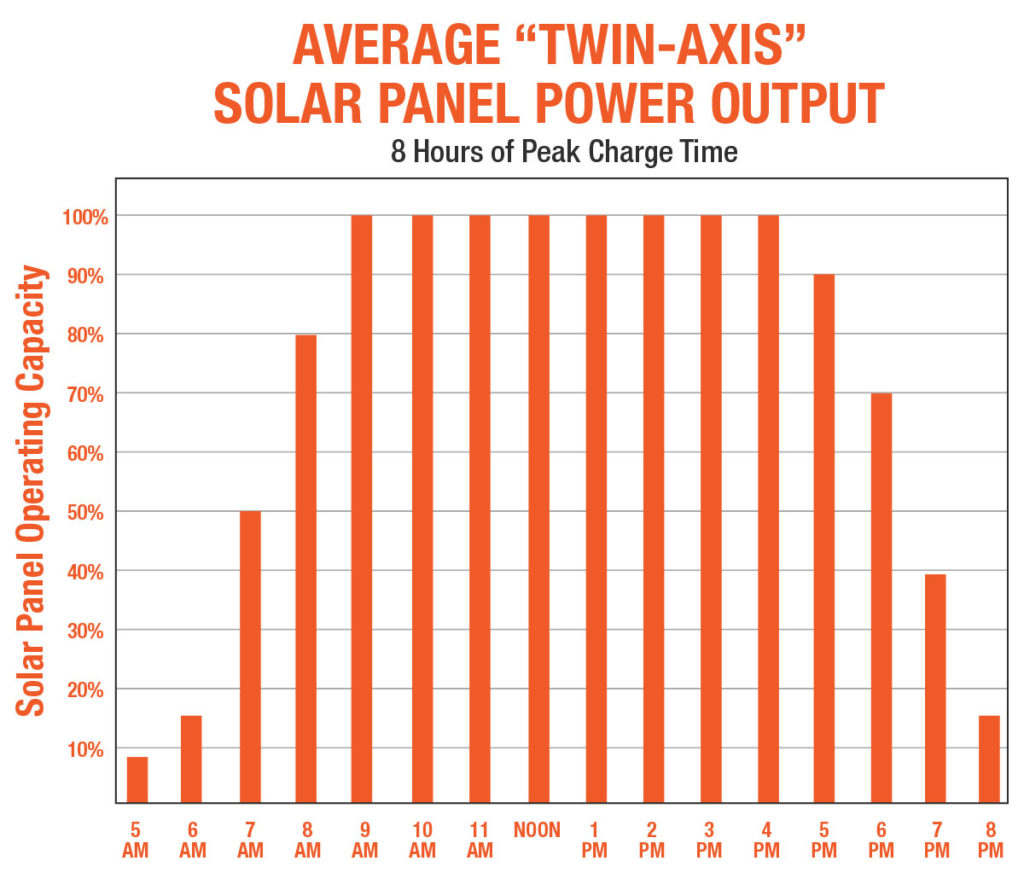
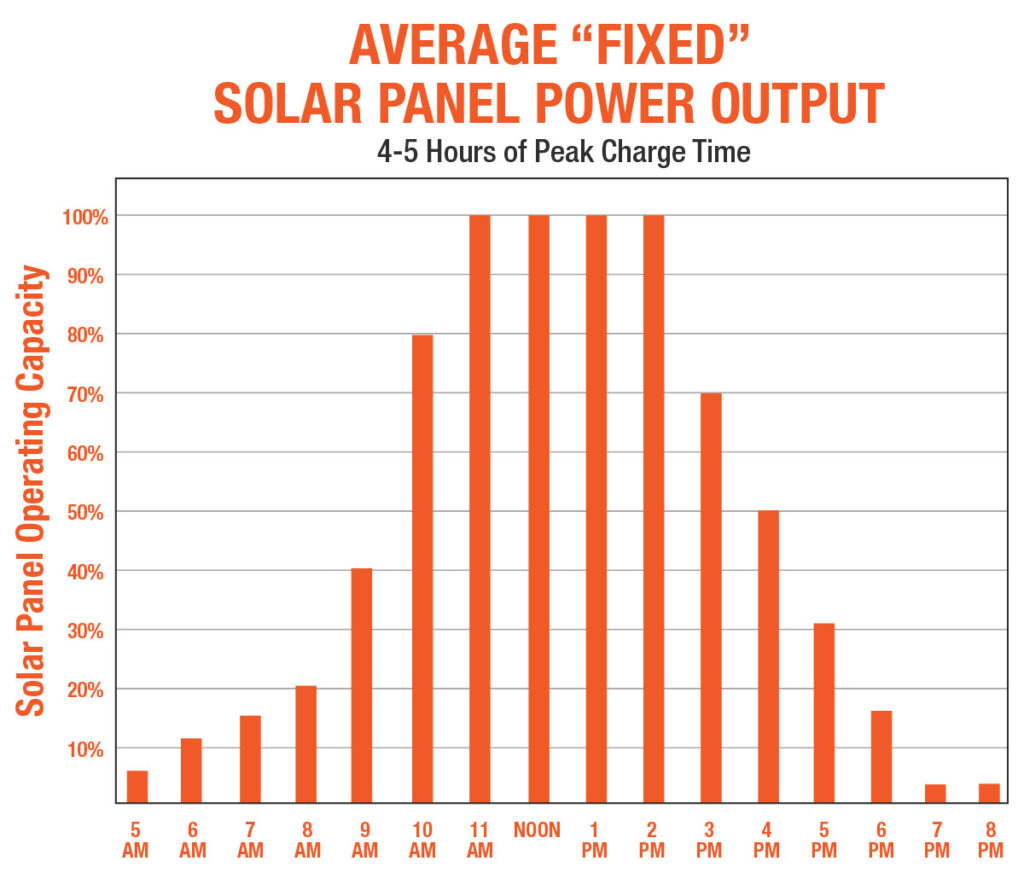
Often, thin-film solar PV arrays are deployed on the ground because of their physical size or application requirements. Such placement can result in negative effects for solar PV panels, including
Operators using thin-film solar PV panels laying on the ground should expect a 40% loss of the array’s rated power output. The easiest way to combat these issues is to deploy extra panels or to raise them slightly off the ground to allow for better airflow and angle to the sun.
Photovoltaic cells (the part of the panel that produces electricity) are encapsulated using multiple layers of materials, which have the potential to alter the heat flow into and out of the PV module. The internal operating temperature of the the PV module is influenced by the amount and type of materials used in the construction and, in some cases, has a major impact on the PV module by reducing its voltage, thereby lowering the output power.
Panel arrays that track the sun automatically or manually, using multiple axes of movement, allow panels to work at 100% of rated output in direct sunlight for a longer period during the day. These arrays generate higher power output for longer times than fixed-angle or single-pitch systems and can adapt to seasonal changes of the sun’s path (declination) across the sky and the daily East-West travel of the sun.
The sun rarely passes directly overhead during the course of a year. Most solar panels mounted in fixed-angle or flat positions (facing straight up) operate at reduced capacity, even during the noon hour. Single-axis solar PV panels often are adjusted only for seasonal changes in the angle of the sun (horizontal axis), but have limited ability to track the daily East-West progression of the sun’s travels. Single-axis tracking is extremely important for arrays that are located in far northern or southern latitudes.
A solar PV array that has a multi-axis tracking system often is as effective as a fixed-mounted panel system two to three times its size. Tracking requires as few as three daily panel adjustments to produce 100% of their rated power output all day long. With tracking, users can achieve 200% to 300% increases in power output over stationary or single-axis systems, depending on geographic location and time of year.
The method of mounting a solar PV panel plays a significant role in the panel’s ability to dissipate heat through one of three mechanisms: conduction, convection, and radiation. These heat-loss mechanisms depend on the thermal resistance of the module materials, the emission properties of the PV module, and the ambient conditions (particularly wind speed) in which the module is mounted. Mounting the panel away from other hot surfaces (such as a roof) will also aid significantly in cooling the panel.
The Solar Stik design features a mechanical arm that allows panel adjustment to maximize solar exposure. A Solar Stik also suspends the panels, allowing good air circulation that keeps the panels cooler and operating at maximum power output.
The following graphs demonstrate the differences in power production between a flat or fixed solar PV array and one that is adjustable on two axes of rotation.
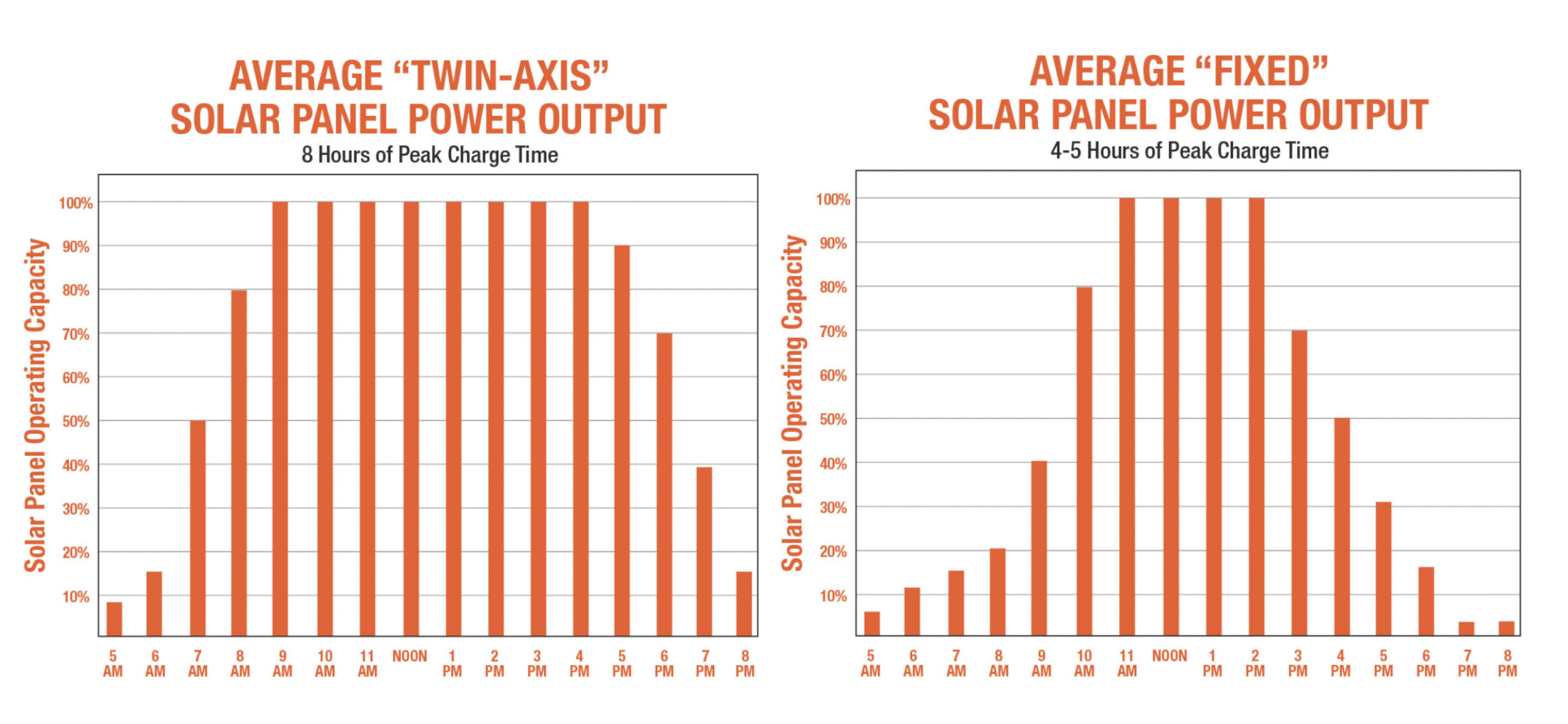
Often, thin-film solar PV arrays are deployed on the ground because of their physical size or application requirements. Such placement can result in negative effects for solar PV panels, including
Operators using thin-film solar PV panels laying on the ground should expect a 40% loss of the array’s rated power output. The easiest way to combat these issues is to deploy extra panels or to raise them slightly off the ground to allow for better airflow and angle to the sun.
A charge controller should always be used between a solar PV panel—or array—and a battery to ensure that a safe charging voltage is applied to the battery. Maximum Power Point Tracking (MPPT) charge controllers serve both the solar PV panel and the battery by algorithmically maximizing the output of the panel and acting as a buffer between panel and the battery.

The MPPT charge controller is “smart” and recognizes the solar PV panel and the battery as individual circuits with completely different characteristics. When MPPT controllers are used in a solar PV system, they allow panels to operate at their rated voltage instead of the battery’s voltage, resulting in about a 25% increase in power to the battery bank when compared to using less efficient charge controllers such as series or shunt-type charge controllers.
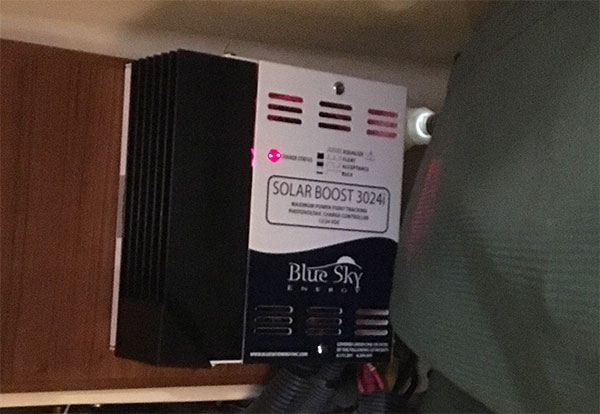

Use only the same PV panel types when building an array—especially if using MPPT charge controllers. Different PV panel technologies often operate at different voltages, so using mismatched panels cancels out the benefit of an MPPT charge controller and makes maximum power production unachievable.
For instance, a flexible amorphous silicon panel should not be connected to a circuit that uses rigid monocrystalline panels. While this connection will not result in damage, it will significantly decrease the total power output of the panel array.
When using thin-film PV panels, it may be possible to daisy-chain connectors to add thin-film PV panels to an array, allowing operators to scale their systems to meet their power requirements. Connecting additional panels does not always provide an increase in power because the small wiring in the construction of many thin-film PV panels limits the amount of power they can safely conduct. Consult the panel’s literature for information about adding panels.
How MPPT and other solar charge controllers work is explained in detail, with examples, in the Power Management module.

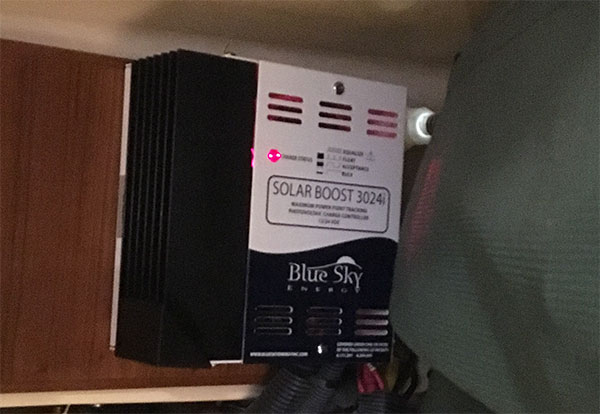


Battery Voltage
Battery voltage, or state of charge (SOC), of a lead-acid battery can be estimated by measuring the open (no load) battery terminal voltage using a digital voltmeter. Prior to measuring, the battery must have rested for 4 to 8 hours after charge or discharge and resided at a steady room temperature. With these conditions met, voltage measurements provide an amazingly accurate SOC for lead-acid batteries.
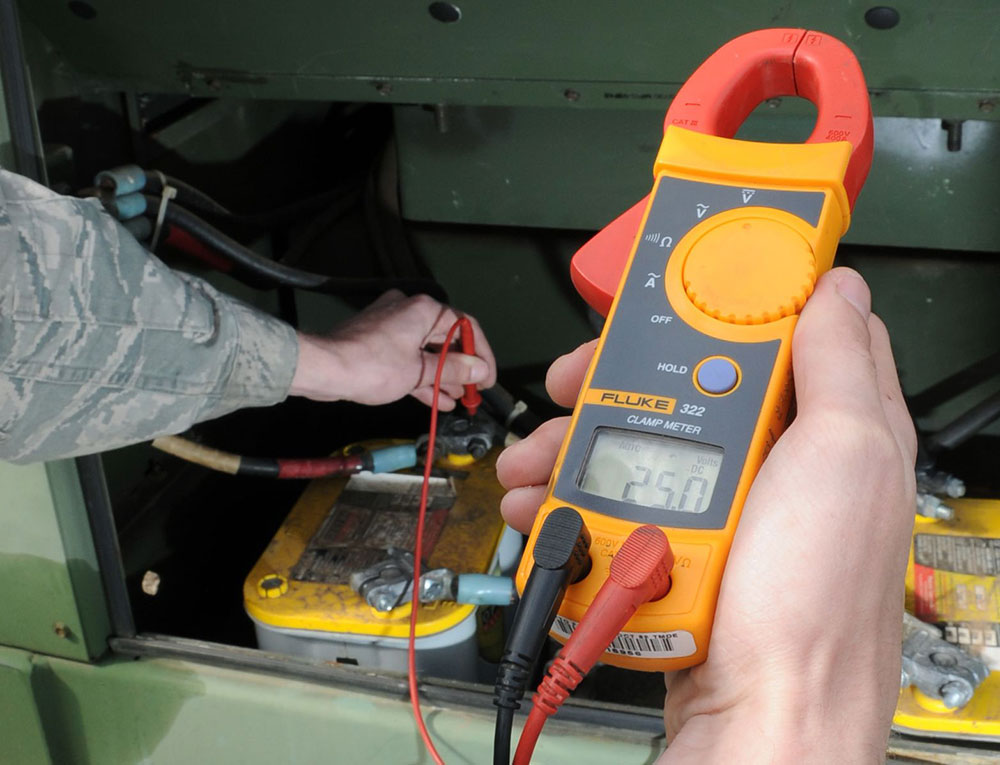
Specific Gravity
Specific gravity can be measured in wet-cell batteries with removable caps that provide access to the electrolyte. To measure specific gravity, you must use a tool called a temperature-compensating hydrometer, which can normally be purchased at an auto parts store or tool supply.
Load Testing
Load testing removes and measures the amps from a battery, similar to what happens when you start the engine of a car. Some battery companies label their battery with the amp load for testing. This number is usually about half of the CCA rating. A battery rated at 500 CCA would therefore be load-tested at 250 amps for 15 seconds.
A load test can only be performed if the battery is at or near a full charge. Some electronic load testers apply a 100-amp load for 10 seconds, and then display battery voltage. This number is then compared to a chart on the tester, which compares common load testing results to CCA ratings to determine battery condition.
Solar Stik uses only lithium iron phosphate (LiFePO4) battery chemistry in its lithium-ion energy storage products because it has safety characteristics similar to lead-acid batteries. LiFePO4 uses a nonflammable electrolyte, so when it’s completely discharged it becomes inert, making it safe for users.
In some lithium-ion polymer batteries, improper charging and storing can cause the formation of crystalline “needles” that can puncture the internal separator, resulting in failure or fire. This is not the case with LiFePO4 batteries because the reactants that store the charge are not flammable. All other lithium battery chemistries are volatile, reactive, and flammable, and if they do overheat and catch fire, conventional halon fire extinguishers will not put out the fire.
Common LiFePO4 cell types include cylindrical and prismatic (LiFePO4 chemistry is not packaged in pouch cells, another lithium cell type). It is easy to see how these were named, as they are actual descriptions of their physical attributes; they look like what they sound like.

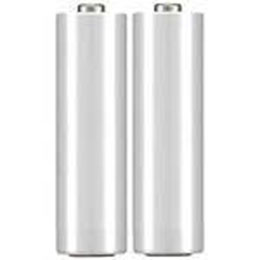
Cylindrical
LiFePO4 cylindrical cells are all made of the same basic components. Each cell, and the entire battery, is enclosed by a resilient plastic container. Inside the container there is a “rolled” foil, and between the foil there is a layer of permeable “separator” material. A safe, nonflammable electrolyte (unique to LiFePO4) is added to each cell and saturates the “foil” and “separator”. The battery terminals are typically threaded (rather than posts) so that heavier-duty connections can be made to the load.
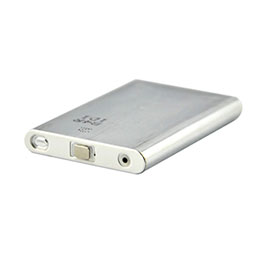 Prismatic
Prismatic
LiFePO4 prismatic cells make optimal use of space by using the layered approach. Small, flat versions are used in mobile devices where space is at a premium. The terminals can be oriented in any direction, which is an important feature for handheld devices. The smaller formats often have a softer, more flexible exterior and are sometimes referred to as pseudo-prismatic jellies.
Larger versions of the prismatic format are used to power vehicles and are often housed in welded aluminum housings. Stronger exterior housings are often required to compensate for the structurally softer inner construction of the prismatic format. Less efficient thermal management is inherent in their design, and overheating can reduce the life cycle and cause the cells to swell. If this occurs, remove and replace the battery before there is any damage to the component using the battery.
LiFePO4 is slightly less powerful than other commercially available lithium chemistries, but for many applications, the safety of its chemistry makes it the best choice despite its lower energy density. A LiFePO4 battery can be installed safely in any orientation. Safety vent valves are usually not required because the battery management system (BMS) will not allow the battery to overheat and vent gasses.
History of Lithium-ion Batteries
Experimental lithium batteries were developed as early as 1912, but it took nearly 70 years before a commercial lithium battery was developed for a wide market. Today, lithium batteries are most associated with enhancing “portable” capabilities. For example, they are the standard battery technology for high performance in portable electronics ranging from cell phones to laptop computers. There is a diverse family of lithium chemistries available. At first glance, they might all seem to be the same, but there are exploitable, distinct differences between them. The unique nature of the various chemistries allows each type to fill special application niches.
Even with wide market adoption in the early 1990s, as societal demands for lightweight portable electronics was burgeoning, the high cost barrier and complexities in battery management circuits would prevent lithium batteries from being used widely in support of larger devices or in scaled energy-storage systems such as large vehicles or uninterruptible power supply (UPS) systems.
Today, lithium battery technology continues to evolve at a rapid pace. Manufacturers, driven by demands from new applications, are constantly pushing the envelope by making changes in the chemistry and structure in search of improved battery life and greater energy density.
Lead-acid batteries are the most commonly used batteries and come in several different configurations. The oldest of the lead-acid battery types are flooded-cell (or wet-cell) batteries and can be either the sealed or the open variety. In both types, the electrolyte evaporates due to charging, age, or ambient heat.
In the mid 1970s, a “maintenance-free” valve-regulated lead-acid (VRLA) battery was developed.
VRLA batteries can be absorbed glass mat (AGM) or gel cells. Solar Stik uses AGM batteries in its lead-acid products.
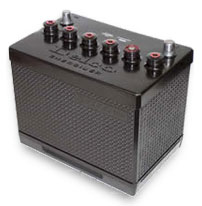
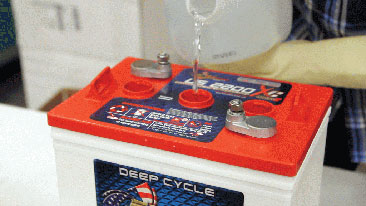
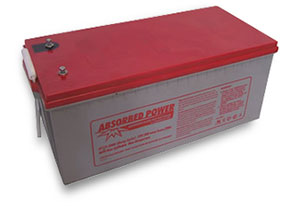
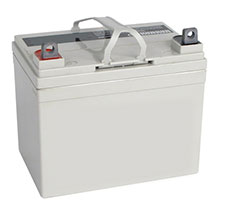
VRLA batteries remain under constant pressure of 1–4 psi. This pressure helps the recombination process during charging when more than 99% of the hydrogen and oxygen generated are turned back into water.
Unlike the flooded lead-acid battery, VRLA batteries are designed with a low overvoltage potential, which prohibits the battery from reaching its gas-generating potential during charge. This safeguard prevents excess charging, which would cause gassing and electrolyte depletion.
History of Lead-acid Batteries
Lead-acid is the oldest rechargeable battery technology in existence. Invented by the French physicist Gaston Planté in 1859, lead-acid was the first rechargeable battery to be used in commercial applications. More than one hundred fifty years later, we still have no real cost-effective alternatives for cars, boats, RVs, wheelchairs, scooters, golf carts, and UPS systems.
The lead-acid battery is still the most widely used 12 V energy storage device. A lead-acid battery is an electrical storage device that uses a chemical reaction to store and release energy. It uses a combination of lead plates and an electrolyte to convert electrical energy into potential chemical energy and back again.
There are many newer battery technologies available in the marketplace. However, lead-acid technologies are better understood and are widely accepted as the standard by which all other batteries are measured. Newer technologies often have operational constraints, including maximum and minimum operating temperatures and special charging requirements that make them less versatile and useful for the average consumer in everyday applications.
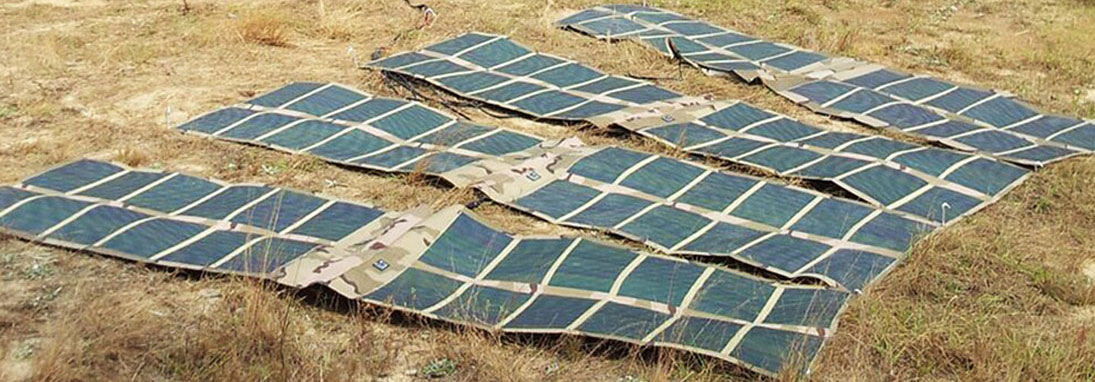
Flexible solar PV panels fuse form factor with capability and deliver maximum power generation with minimum weight. Flexible panels use amorphous silicon or copper indium gallium selenide (CIGS) thin-film technology, which can be used with many substrate options that allow flexible panels to be folded or rolled.
Solar Stik uses extremely rugged, paper-thin, flexible PV panels that can withstand harsh conditions.
As the name implies, thin-film solar PV cells lack the thickness of other PV technologies. Composed of a very thin layer of substance on a substrate, today’s thin-film cells are one percent as thick as the first manufactured silicon solar cells.
Foldable or rollable thin-film panels make storage and transport convenient. For low-power applications that require portability, thin-film solar PV panels are an excellent option.
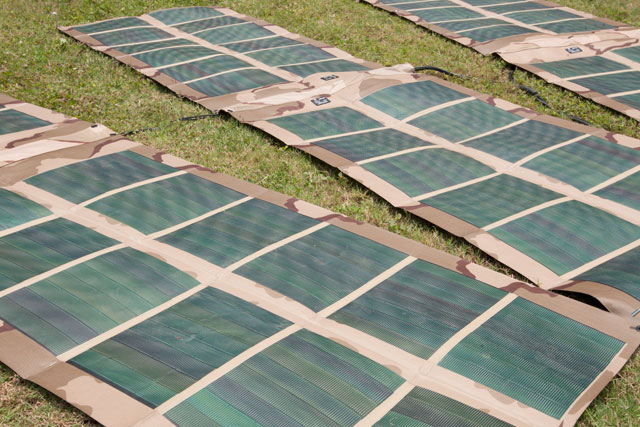
Numerous thin-film solar PV technologies exist today. However, they are slightly less efficient than other types of PV cells, so more surface area is required to generate the same amount of power. Most thin-film panels are designed for single-device applications, like recharging a battery-operated device.
The two most common types of thin-film solar PV panels are amorphous silicon and copper indium gallium selenide (CIGS).
![]()
Amorphous Silicon Solar PV Panel
Amorphous silicon is the oldest thin-film technology and arguably the best. When laid on a substrate, amorphous silicon does not require a grid configuration to conduct electricity, allowing it to be used on large areas with ease. However, it does not conduct as well as crystalline silicon solar PV cells used in rigid panel technology because the connections between the silicon atoms are not as consistent. This inconsistency results in interrupted electron flow.
Numerous substrate materials can be used with amorphous silicon, making the technology highly adaptable. Polymer plastic is one option for substrate. Because polymer plastic is flexible and able to be folded or rolled, it excels in applications requiring ease of storage or transport.
Amorphous silicon solar PV panels perform better in low light intensities. This makes amorphous silicon a good choice for environments with interrupted sunlight or dusty conditions.
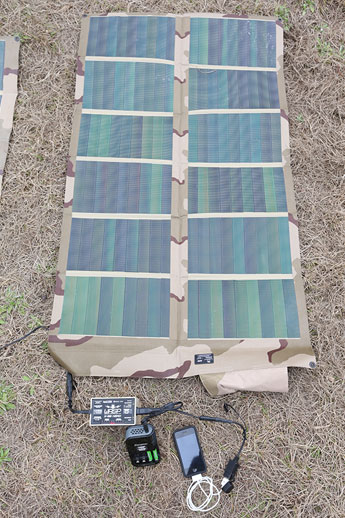
Copper, Indium, Gallium, Selenide (CIGS)
Copper, indium, gallium, and selenide comprise the photoelectric layer of a CIGS solar cell. The principles behind the operation of CIGS PV cells are the same as those for silicon cells, like those used in mono- and polycrystalline solar PV panels.
With CIGS cells, copper acts to receive electrons in a fashion similar to the positive layer (P-type silicon) of a silicon cell. Selenium provides extra electrons to act in the same way as the negative silicon layer (N-type silicon). These materials can be placed onto a variety of substrates, including thin flexible steel, glass, and polymers. Flexible steel is the most widely used because of its resistance to the high temperatures needed to lay the PV elements on the backing sheet.
CIGS panels have a higher-rated output per square foot of surface area than amorphous silicon panels, which allows for relatively smaller CIGS panel sizes to achieve an equal amount of power. However, CIGS panels occasionally require direct exposure to sunlight—a process known as “light soaking”—before they can be used after being stored in dark, hot conditions.
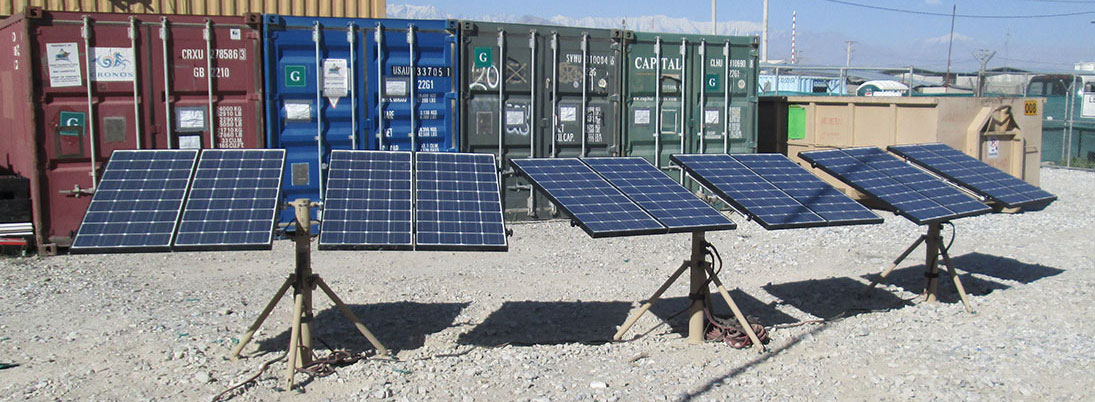
Rigid solar PV panels are ideal for stationary applications that require maximum power and a small installation footprint. They are the first generation of solar PV panels, provide more power per square foot than other PV panel types, and are highly durable. Rigid panels do not degrade significantly over time, making them a good choice for long-term investment.
Solar Stik uses both multi- and monocrystalline, glass and non-glass—impact-resistant and shatterproof—rigid panels.
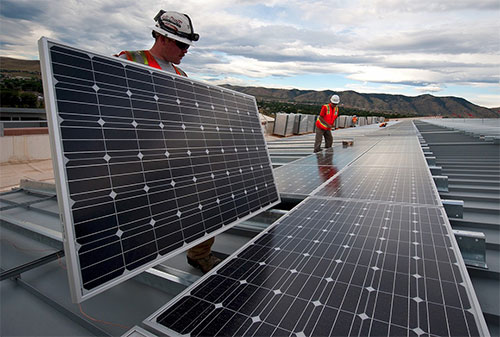
Rigid solar PV panels are typically made of glass or non-glass panels and aluminum frames. Rigid panels are among the best performing panels, but their physical characteristics make them a poor choice for certain applications—especially when portable power is desired.
Travel and storage can be difficult because rigid panels often contain breakable glass and cannot be folded.
The Solar Stik system design overcomes many of the physical challenges associated with the rigid panels. This results in portable power systems that draw from the best available PV technology.
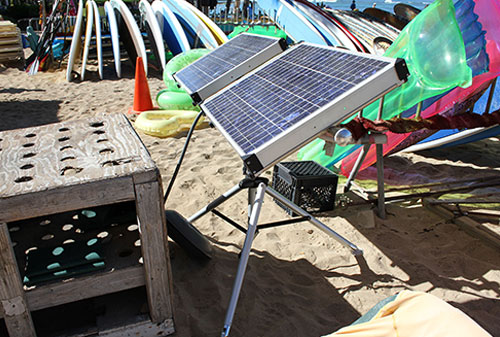
The two main types of rigid solar PV panels are monocrystalline and multi- or polycrystalline.
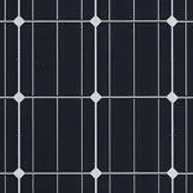
A rigid monocrystalline solar PV panel is distinctly recognizable by the arrangement of the individual solar PV cells (squares with no corners) that appears as a uniform, flat color.
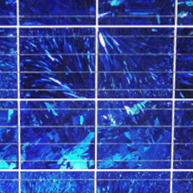
The surface of a rigid multi- or polycrystalline solar PV panel has the appearance of a rectangular grid and more of a bluish speckled color.
Performance differences between rigid solar PV panels can be experienced in high operating temperatures and shaded conditions. Monocrystalline panels perform better in higher external temperatures and full sun. Multi- or polycrystalline panels suffer performance losses in higher heats but have slightly higher outputs compared to monocrystalline panels when the panel is partially shaded.
The role of the battery management system (BMS) is simple: It controls the actual voltage of each cell, so that it doesn’t get too high or too low.
2Prolong the life of the battery
3Maintain the battery in a state in which it can fulfill the functional requirements of the application
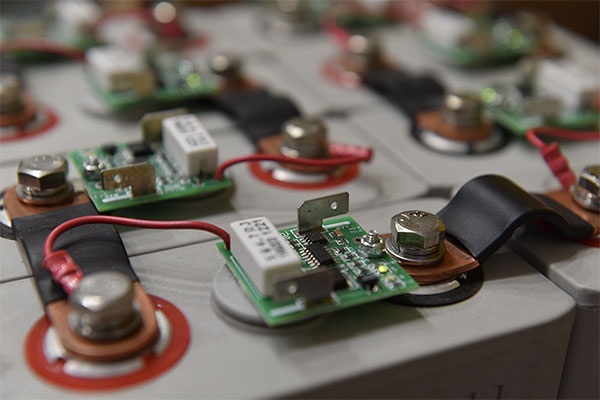
To achieve these objectives, the BMS may incorporate one or more of the following functions:
Cell Protection Protecting the battery from out of tolerance operating conditions is fundamental to all BMS applications. In practice the BMS must provide full cell protection to cover almost any eventuality. Operating a battery outside of its specified design limits will inevitably lead to failure of the battery. Apart from the inconvenience, the cost of replacing the battery can be prohibitive. This is particularly true for high voltage and high power automotive batteries which must operate in hostile environments and which at the same time are subject to abuse by the user.
Charge Control This is an essential feature of BMS. More batteries are damaged by inappropriate charging than by any other cause.
Demand Management While not directly related to the operation of the battery itself, demand management refers to the application in which the battery is used. Its objective is to minimize the current drain on the battery by designing power saving techniques into the application’s circuitry and thus prolong the time between battery charges.
State of Charge (SOC) Determination Many applications require a knowledge of the state of charge of the battery or of the individual cells in the battery chain. This may simply be for providing the user with an indication of the capacity left in the battery, or it could be needed in a control circuit to ensure optimum control of the charging process.
State of Health (SOH) Determination The state of health is a measure of a battery’s capability to deliver its specified output. This is vital for assessing the readiness of emergency power equipment and is an indicator of whether maintenance actions are needed.
Cell Balancing The many cells that constitute a battery can sometimes charge and discharge at different rates, depending on the cell temperature, age, and factors that occur during manufacture of the cells. Over time, these differences will become amplified if they are not corrected. It is important that while charging and discharging, the balance between all cells is maintained. If cells are out of balance, the entire battery pack is shut off when the weakest cell drops below the lower voltage limit, even if other cells are still not completely discharged. Cell balancers are usually placed throughout the cell circuit in order to maintain a balanced charge throughout the entire battery and thereby extending the life of the battery.
To minimize performance differences, BMS components called Protection Circuit Modules or Protection Circuit Boards (PCMs or PCBs) are connected to each cell. The PCBs constantly monitor and report critical parameters of each cell and make small adjustments to correct for any differences between cells. Balancing or equalizing all parameters of each cell in a battery is critical to ensure full life and capacity from a lithium battery.
History (Logbook Function) Monitoring and storing the battery’s history is another possible function of the BMS. This is needed in order to estimate the SOH of the battery, but also to determine whether it has been subject to abuse. Parameters such as number of cycles, maximum and minimum voltages and temperatures, and maximum charging and discharging currents can be recorded for subsequent evaluation. This can be an important tool in assessing warranty claims.
Authentication and Identification The BMS also allows the possibility to record information about the cell, such as the manufacturer’s type designation and the cell chemistry, which can facilitate automatic testing, and the batch or serial number and the date of manufacture, which enables traceability in case of cell failures.
Communications Most BMSs incorporate some form of communications between the battery and the charger or test equipment. Some have links to other systems interfacing with the battery for monitoring its condition or its history. Communications interfaces are also needed to allow the user access to the battery for modifying the BMS control parameters or for diagnostics and testing.
Bricking a LiFePO4 Battery
As soon as the BMS senses that the cell voltage is too low to discharge, time is of the essence to place the batteries on charge. Failure to do this may cause a fatal error known as “bricking”. Once the batteries reach their internal disconnect voltage, the voltage can fall very rapidly in the internal cells, causing the battery to brick. This means that the battery cells are nonrecoverable, and the battery module must be replaced.
Specific gravity of the electrolyte can be defined as:
A measure of the density of the liquid electrolyte compared to the density of water at a specific temperature and pressure.
The chemical reaction takes place inside the pores of the active material on the battery’s lead plates. If the battery has just been charged, the electrolyte in the pores of these lead plates is very rich in sulfuric acid. As a result, the battery’s voltage will be high, perhaps as much as 13 to 14 volts. As the battery rests following a charge, its voltage slowly drops and then levels off as the electrolyte stabilizes its chemical state between the plates.

“Zero Gravity” by Scott Robinson is licensed under CC BY 2.0
A similar change in battery voltage occurs during discharge. During the battery discharge process, the electrolyte transfers its sulfur content to the lead plates. As the electrolyte loses sulfur, its specific gravity gets “lighter” or closer to that of water, indicating that the battery has been discharged. Because the specific gravity of the electrolyte is measurable, it can be used to determine the state of a battery’s charge and health. While a fully charged battery may read 12.68 volts, the voltage will drop and then stabilize at a somewhat lower value as a load is applied.
The change in voltage occurs even though the state of charge of the battery has not significantly changed. This is due to the local electrolyte in the pores of the plates becoming less rich in sulfur as the battery supplies current. As the battery discharges, electrolyte more like sulfuric acid enters the pores while electrolyte more like water exits the pores.
As discharge continues, the electrolyte in the pores eventually stabilizes at a specific gravity somewhat lower than the average value in the battery, producing the slightly lower battery voltage.
The operational characteristics of the lead-acid battery can be explained best by the terms capacity and cold-cranking amps (CCA).
Capacity is the amount of energy a battery can store. It is usually given in amp hours (Ah), or the amount of current measured in amps that the battery can provide over a period of one hour before rendering the battery discharged.
The secret of any battery’s runtime lies in the battery’s plate capacity. During charging and discharging, the lead on the plates gets gradually eaten away and the sediment falls to the bottom. The service life of a lead-acid battery can be measured by the thickness of the positive plates. The thicker the plates, the longer the life will be and the more energy storage you can expect.
The weight of a battery is another good indicator of the lead content and the life expectancy. Generally speaking, the heavier the battery, the more lead it contains and the longer it will last.
Most industrial flooded deep-cycle batteries use lead-antimony plates. Antimony is a metal that stiffens the lead plate and helps prevent battery failure due to structural failure of a plate. This improves the plate’s life but increases gassing and water loss. Antimony is not necessary in AGM batteries due to the rigid construction of the overall battery.
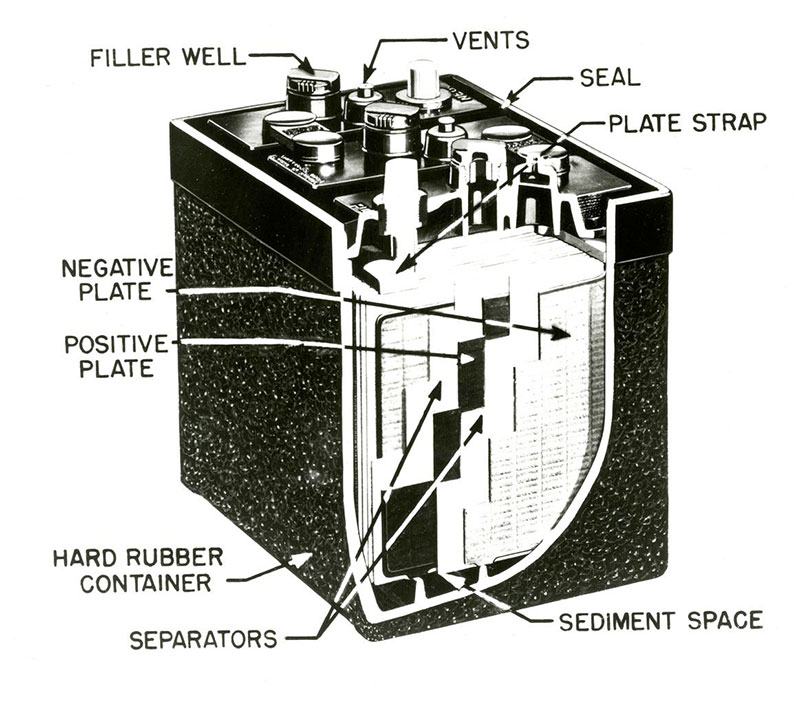
1953 automotive lead-acid battery

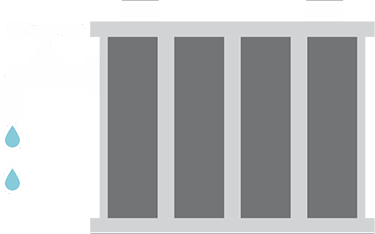
Cold-cranking amps (CCA) is the amount of energy a battery can deliver in short bursts. It is the maximum amount of current (amps) that a battery can deliver at 0 °F for 30 seconds without dropping below 7.2 volts. A high CCA battery rating is good, especially in cold weather. Starter batteries are often rated in CCA and are designed to deliver a short-duration burst of power, such as that required to start a vehicle.
Age and environmental conditions can affect the capacity and the CCA. As a battery ages, capacity and CCA will not degrade at the same rate. CCA tends to stay high through most of the battery’s life, but it drops quickly towards the end. If you drive a car, you’ve probably experienced this when, near the end of the battery’s life, suddenly the battery won’t start the car in the morning.


Capacity decreases gradually. A new battery is designed to deliver 100% of its rated capacity. As the battery ages, the capacity steadily drops and it should be replaced when its ability to store power falls below 70% of its original rating.
The overall health of a battery is most directly related to its capacity, not its CCA. As noted before, the CCA remains within the optimal range for most of a battery’s life, so performance and health declines will be most notable in the loss of capacity.
The illustration shows two fully charged lead-acid batteries, one with a high capacity and one that has aged. The buildup of visible “rock content” (crystalline formation, also called sulfation or memory) due to aging robs the battery of usable capacity, although the battery may still provide good cranking power.
Appliance efficiency is also known as load efficiency. As appliances consume less power, power source requirements also change. When designing a portable power system, purchasing highly efficient components can provide many benefits.
Appliance loads can often be matched to the electrical characteristics of the circuit. This will increase the system’s overall efficiency by allowing direct connection to the circuit without the need for additional power management devices to aid in the function.
The fewer management components used in a system, the more efficiently it will operate. For example, components such as inverters, converters, or similar devices used in a circuit to “adapt” appliances for use in a particular electrical circuit themselves require power to operate, and thus the total power required to operate the appliance is increased.
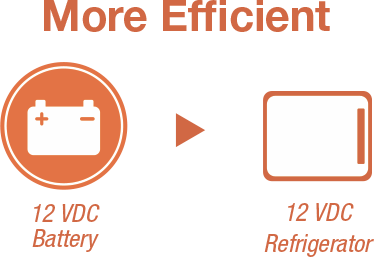
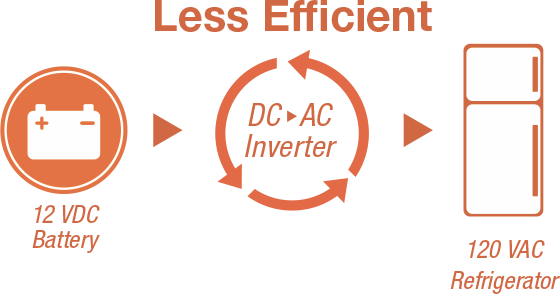

For example, a 12-volt direct current (DC) electrical circuit powered by a 12 V battery can directly support a refrigerator that also operates at 12 VDC. This setup will transfer power through the circuit more efficiently than if the refrigerator requires 120 V alternating current (AC) power. In the latter example, an inverter would be required.
It is prudent to shop around when looking for appliances because power consumption varies among models even within a particular appliance class. Purchasing an energy-efficient device can be more expensive up front, but could mean future savings in energy costs as well as a flexibility of use that makes the device compatible with a variety of portable power sources. When purchasing an electrical appliance, remember to ask if a 12 VDC adapter is available for the product.
A pure sine (also referred to as a sinusoidal) wave can be produced by rotating machinery (a generator). This is the type of waveform provided by electric utility companies. This type of power is available anywhere an outlet is tied to the power grid, such as in homes or businesses.
A PSW inverter reproduces this waveform through the use of advanced internal circuitry.
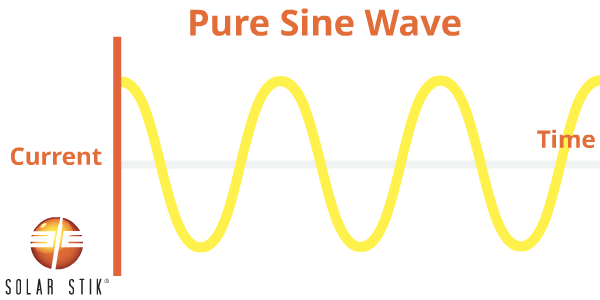
A modified sine wave (also referred to as non-sinusoidal or step-wave) inverter is different from a pure sine wave power inverter because the modified waveform output is step-shaped.
AC appliances that are not specifically designed to work with this type of inverter waveform output may take more power to operate, thereby reducing the efficiency of the entire electrical system. For example, some appliance motors may produce more heat and burn out when they are operating.
Other appliances that use electronic controls will not be able to vary speed or temperature when using modified sine wave power. Some fluorescent lighting may not get as bright or may make buzzing noises. Appliances with digital clocks or electronic timers may not work properly with this type of inverter because the waves are rougher and cause extra noise to be created in the circuitry.
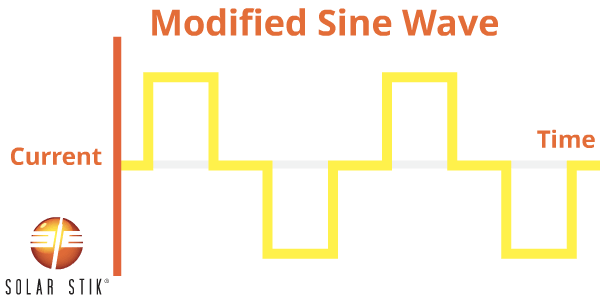
The following appliances may experience problems when operated from MSW inverters:
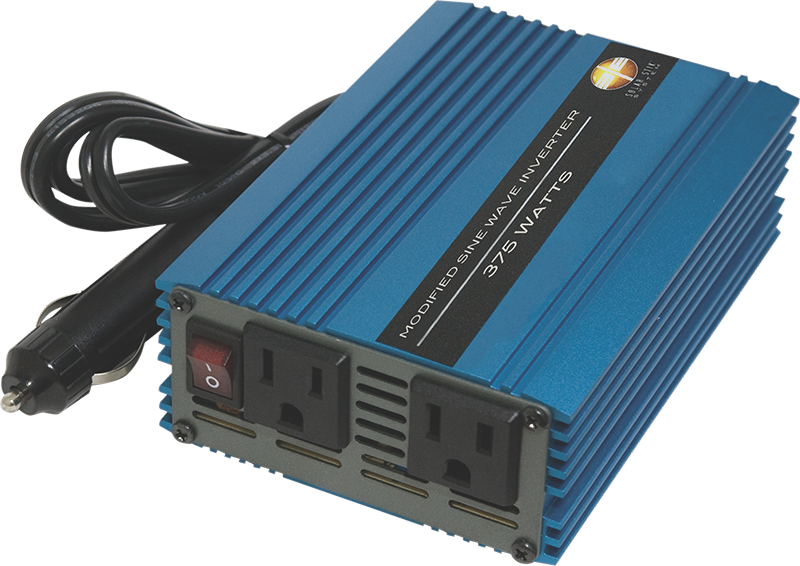
Low-wattage Inverters
Most vehicle starting batteries will support a low-wattage inverter for short time periods. Actual operating time will vary depending on the age and condition of the battery, the Ah capacity of the battery, and the AC appliance powered by the inverter. If you use a low-wattage inverter that is powered through a DC accessory socket, and the vehicle engine is turned off, you should periodically run the engine to recharge the battery.
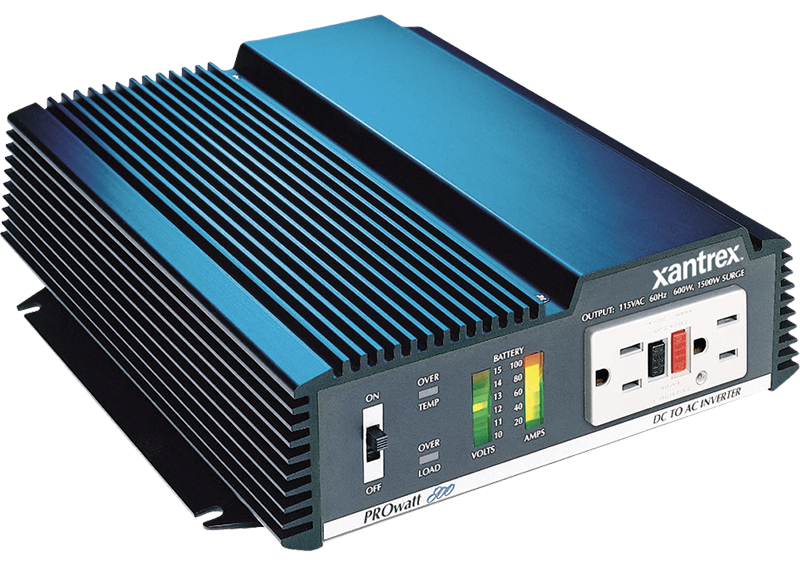
Medium- and High-wattage Inverters
It is strongly recommended that only deep-cycle batteries be used for any inverter with a continuous output of 200 W or more. This will ensure that you have several hundred complete charge and discharge cycles. If you use a normal vehicle starting battery to support a medium- or high-wattage inverter, it will quickly fail after repeated charge/discharge cycles (since starting batteries are not designed to perform this type of work).
When the inverter operates power-hungry appliances with continuous loads for extended periods, it will drain the battery to the point where the battery has insufficient energy to support the inverter. In these cases, it’s a good idea to have additional deep-cycle batteries available to extend the appliance operating time.
Lead-acid batteries are the most commonly used batteries and come in several different configurations. The oldest of the lead-acid battery types are flooded-cell (or wet-cell) batteries and can be either the sealed or the open variety. In both types, the electrolyte evaporates due to charging, age, or ambient heat.
In the mid 1970s, a “maintenance-free” valve-regulated lead-acid (VRLA) battery was developed.
VRLA batteries can be absorbed glass mat (AGM) or gel cells. Solar Stik uses AGM batteries in its lead-acid products.
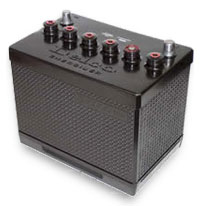
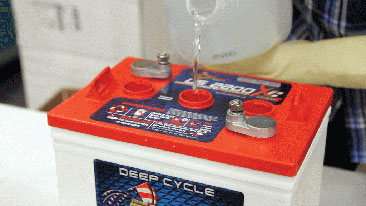
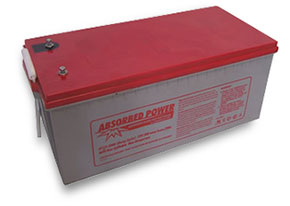
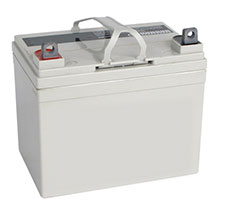
VRLA batteries remain under constant pressure of 1–4 psi. This pressure helps the recombination process during charging when more than 99% of the hydrogen and oxygen generated are turned back into water.
Unlike the flooded lead-acid battery, VRLA batteries are designed with a low overvoltage potential, which prohibits the battery from reaching its gas-generating potential during charge. This safeguard prevents excess charging, which would cause gassing and electrolyte depletion.
History of Lead-acid Batteries
Lead-acid is the oldest rechargeable battery technology in existence. Invented by the French physicist Gaston Planté in 1859, lead-acid was the first rechargeable battery to be used in commercial applications. More than one hundred fifty years later, we still have no real cost-effective alternatives for cars, boats, RVs, wheelchairs, scooters, golf carts, and UPS systems.
The lead-acid battery is still the most widely used 12 V energy storage device. A lead-acid battery is an electrical storage device that uses a chemical reaction to store and release energy. It uses a combination of lead plates and an electrolyte to convert electrical energy into potential chemical energy and back again.
There are many newer battery technologies available in the marketplace. However, lead-acid technologies are better understood and are widely accepted as the standard by which all other batteries are measured. Newer technologies often have operational constraints, including maximum and minimum operating temperatures and special charging requirements that make them less versatile and useful for the average consumer in everyday applications.
Lead-acid batteries are commonly made of five basic components:
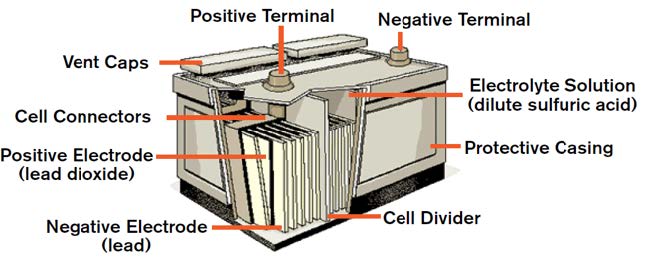
A battery cell is a container in which electrolyte and lead plates can interact. The electrolyte is usually a solution made up of 35% sulfuric acid and 65% water. The lead plates are treated with lead oxide and powdered sulfates to give them their positive and negative properties.
When the positive and negative lead plates are submerged in the battery’s electrolyte, a chemical reaction occurs. This reaction causes electrons to flow between the lead plates. The negative lead plate builds up an excess of electrons in a process called oxidation. This causes an electrical difference between the negative plate and positive plate.
The extra electrons on the negative lead plate want to displace the electrons on the positive plate in a process called reduction. However, the electrolyte solution of sulfuric acid and water ensures the electrons cannot travel directly to the positive plate. When the circuit is closed (with the help of a “conductive path”, or load, between the negative and positive plates), the electrons are able to travel to the positive plate. This, in turn, provides power to any appliance placed along the path.
This electrochemical process can be summarized as a reversible transfer of sulfate between the water and the lead plates during charging and discharging. As the battery is discharged, sulfate in the solution combines chemically with the lead plates of the battery to form lead sulfate. As the plates accumulate this sulfate, the electrolyte solution becomes more like water and less like sulfuric acid. The reverse occurs as the battery is charged. As charging current flows into the battery, the battery plates revert back to their original condition and the electrolyte reverts back to its original sulfuric acid content.
Lithium-ion batteries are made of the following basic components:
The exact chemistry is often patented and proprietary to each battery maker.
When a charge is applied to a lithium-ion battery, electrons flow between the internal components. The basis of this reaction is the lithium metal binding and unbinding with the other chemicals in the electrodes at the ionic level. As power is drawn out of the battery, the metal moves from one electrode to the other, and when the battery is charged, it moves back to the original state. The metallic lithium ions literally move through the separator material.